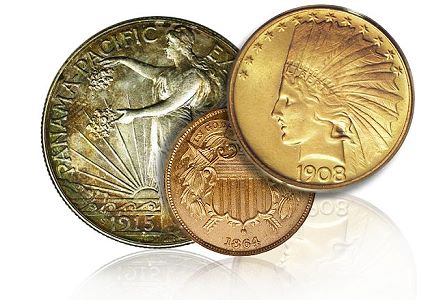By Mark Ferguson for CoinWeek – MFrarecoins.com
To see where the coin market is headed into the future it’s often helpful to look back at how it’s evolved over time. When we look back at the coin market over several decades we see distinct market trends that have occurred during various time periods. For example, during the 1960s the coin market experienced an uncirculated “roll” boom. The market got really hot for uncirculated bank rolls of all the denominations in use at that time, from Lincoln cents to silver dollars, as well as any design types previously used, if you could find them.
 It was not uncommon to encounter uncirculated rolls of Buffalo nickels, Mercury dimes, Standing Liberty quarters, Walking Liberty half dollars, and Morgan and Peace silver dollars. But Mint State rolls of Lincoln cents, Jefferson nickels, Washington quarters, and the other contemporary coins were hotly sought as well, especially if they were scarce dates. Buyers chased these rolls of coins, driving prices to sky-high levels, then the market for these coins quickly crashed.
It was not uncommon to encounter uncirculated rolls of Buffalo nickels, Mercury dimes, Standing Liberty quarters, Walking Liberty half dollars, and Morgan and Peace silver dollars. But Mint State rolls of Lincoln cents, Jefferson nickels, Washington quarters, and the other contemporary coins were hotly sought as well, especially if they were scarce dates. Buyers chased these rolls of coins, driving prices to sky-high levels, then the market for these coins quickly crashed.
Soon after, on June 24, 1968, the Federal government stopped redeeming the old “Silver Certificates” in circulation because the price of silver had climbed so high that there was more than a dollar’s worth of silver in a silver dollar. Silver Certificates were circulating one, five, and ten dollar bills that could be redeemed by the Federal government for a certain amount of physical silver bullion. At the peak of the market dealers were paying close to $2 for the one dollar Silver Certificates. A huge amount of business was done by coin dealers who bought Silver Certificates from the public and redeemed them for silver, pumping a very large amount of capital from their profits into the coin market.
Additionally, as most of us know, our government stopped putting silver into our circulating coinage after 1964 because of the rising price of silver. This led to the hoarding of silver coins by the public. The price of silver continued to climb over the years and then inflation kicked in during the 1970s. The price of silver kept escalating throughout the 1970s, culminating with the famous Hunt brothers’ manipulation of the silver market, causing the price of silver to peak at about $50 per ounce in January, 1980.
The rising trend in the price of silver and a rising trend of price inflation in the general economy during the 1970s caused a tremendous amount of money to enter the coin market. Dealers were making huge profits and pumping those profits into inventory, and investors saw the rare coin market as a great hedge against inflation. The coin market became investor-dominated, pushing prices for rare coins to unprecedented levels, and then the rare coin market suddenly crashed in April, 1980 because of illiquidity that coincided with income tax time.
A long shake-out period in the coin market throughout the 1980s and 1990s, except for a short-term bull market during 1989, returned the coin market to a collector-based market, during which time PCGS, Professional Coin Grading Service, and NGC, Numismatic Guaranty Corporation, were formed, creating new, healthy market dynamics. This set the coin market up to perform well during the economic boom of the 2000s that was accompanied by a bull market in coins.
Now…where is the market going from here? As the prices of rare coins climb over time, middle-class collectors become more limited in what they can afford to collect. When people buy rare coins and are interested in price appreciation, they should to look ahead and anticipate what collectors will want to collect in five, ten or twenty years, for example, and how they will collect and invest in coins.
As prices rise over the long-term, many established collectors quit collecting, often selling their collections, and then switching to collecting another area that is more affordable. An example would be the rising market for early Bust design silver dollars. Some collectors were used to paying $1,500, for example, for many of the different issues of that series in the grade they could afford. But when those same coins began to cost them more than $4,000 several years later, many collectors just sat on the sidelines, and some even sold their collections to start in on collecting other areas of coinage that were more affordable for them. It’s interesting to note that established collectors rarely just sell out and are gone from the coin market. They have collecting “in their blood,” so to speak, and are in it as a life-long endeavor.
So, there’s a personal cap on the prices that middle-class people generally pay for coins for their collections. As prices appreciate, or for coins that are higher priced because of their scarcity, there are a more limited number of buyers, unless the market is expanding with new buyers. A good example of this is during the coin market boom of the 2000s when numerous people purchased multiple examples of key date coins as an investment. It turns out these buyers ran up the prices for collectors, squeezing them out of the market, and prices fell for many key date coins. The investors lost and the collectors who waited to buy won with lower prices.
One collecting trend that’s gaining in popularity and is a great alternative to collecting coins by series is to collect coins by denomination and design types. This is called “type coin” collecting. It’s a fun and interesting way to collect because it touches on many series of coins, rather than just one in which collectors collect by date and mintmark. Type coin collecting is also a way to achieve diversification in the coin market from an investment consideration. Collectors are building diverse collections, buying the most affordable grade for each type that they include in their type coin collections. Taking this a step further, some collectors are adding pattern coinage to their collections, if the patterns are pertinent to the main theme of the collection. Patterns are coins that never were. They’re samples of coins that are struck to show government officials proposed designs.
In addition to type coin collecting, some people are building short sets or mini sets of various series. A good example is the Walking Liberty half dollar short set, minted from 1941 to 1947. Collecting the Walking Liberty short set has been commonplace for generations, but now collectors are building similar short or mini sets within other series. Another variation of collecting a mini set is by Mint, such as a collection of “CC” only Mint Morgan silver dollars, which were struck at the U.S. Mint at Carson City, Nevada.
Still another changing trend in the coin market, besides type coin collecting, involves coin grading. Standards are being refined, as demonstrated by the expansion from the 70 point system to the 700 point system PCGS has been using internally for more than a year for their Secure Plus service. Secondly, premium quality coins are being officially recognized by both PCGS and NGC, through their “Plus” grading tiers. This all seems to be prompted by the formation of CAC, Certified Acceptance Corporation. This third-party certification service affixes its “green bean” oval sticker to coins previously graded by PCGS and NGC, and recognizes coins that are at the top tier of a grade. In other words, within a coin grade, such as Mint State 66, there are “A,” “B,” “C,” and “D” quality coins, with “A” quality coins being the best. CAC stickers the “A” and the “B” quality coins within the MS 66 grade, using this example.
This relatively new system of recognizing superior coins within a grade helps the market price premium quality coins higher than average quality coins which were previously dragging down the prices of “A” and “B” quality coins. This is a revolution in the coin market that will continue to be refined as time goes on. Look for price differences between average quality coins and coins designated as premium quality to become greater over time. Current premiums are now ranging from about 5 to 25 percent with occasional premium quality coins trading for 50 percent or more than average quality coins. Price guides are slowly being forced to recognize premium quality coins in their listings.
So when you’re planning your collecting endeavors and hoping to reap a financial reward through price appreciation of your collection in several years’ time, try to think about how the coin market and collecting will be changing during the coming years. I’ve presented some basic concepts here to get you thinking about how the coin market will evolve during the coming years.
 Mark Ferguson was a coin grader for PCGS , a market analyst for Coin Values and has been a coin dealer for more than 40 years. He has written for the ANA, Coin Dealer Newsletter, Coin World, Numismatic News, , Coin Values, The Numismatist and currently has a weekly column on CoinWeek. Mark can be reached at Mark Ferguson Rare Coins ( www.mfrarecoins.com)
Mark Ferguson was a coin grader for PCGS , a market analyst for Coin Values and has been a coin dealer for more than 40 years. He has written for the ANA, Coin Dealer Newsletter, Coin World, Numismatic News, , Coin Values, The Numismatist and currently has a weekly column on CoinWeek. Mark can be reached at Mark Ferguson Rare Coins ( www.mfrarecoins.com)




